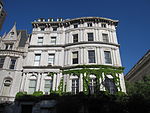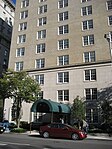Acquavella Galleries
1921 establishments in New York CityArt galleries established in 1921Art museums and galleries in ManhattanContemporary art galleries in the United StatesUpper East Side

Acquavella Galleries is an art gallery located at 18 East 79th Street between Madison and Fifth Avenues in the Upper East Side neighborhood of Manhattan, New York City.
Excerpt from the Wikipedia article Acquavella Galleries (License: CC BY-SA 3.0, Authors, Images).Acquavella Galleries
East 79th Street, New York Manhattan
Geographical coordinates (GPS) Address External links Nearby Places Show on map
Geographical coordinates (GPS)
| Latitude | Longitude |
|---|---|
| N 40.776372 ° | E -73.962617 ° |
Address
East 79th Street 18
10075 New York, Manhattan
New York, United States
Open on Google Maps








